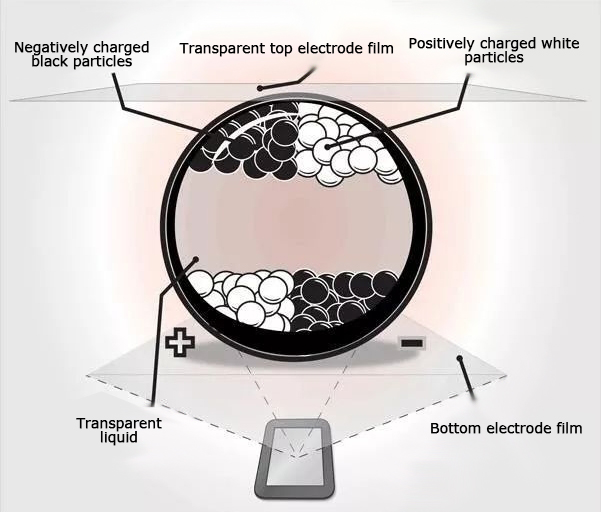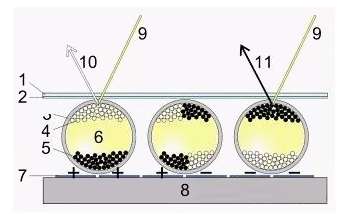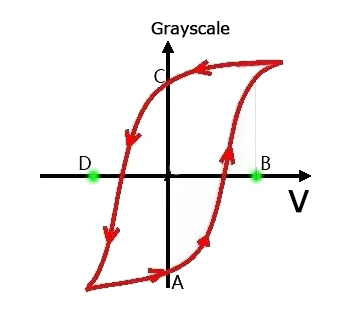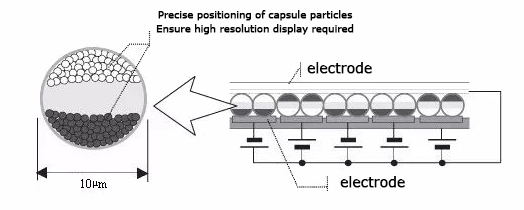Techlion Display
LCD Module Manufacturer
In-depth interpretation of E-link – e-ink screen technology
Reading e-books has long been a part of everyone’s life, convenient and lightweight electronic version of the book is easier to carry, and e-reader is not only limited to computers, cell phones and other traditional equipment, the emerging e-book reader is gradually accepted by us. e-ink e-ink technology is now one of the most famous products, he appeared in the e-book reader is no longer the LCD screen a dominant.
Mention E-ink electronic ink screen, the first reaction is “Oh, that is that can only display black and white gray screen, right, Amazon Kindle e-book is to use this”.
E-ink screen with close to the reading experience of paper books, Kindle as the representative of the e-book has become a lot of reading enthusiasts must go out with the digital equipment to save power, eye protection gimmick of a variety of e-ink screen devices also began to appear. After so many years of development, e-ink screen seems to be the same as it was at the beginning of its birth. From the perspective of ordinary consumers, it has not become mainstream, but it has never left.
Contents
- 1 The origin of E-link technology
- 2 The basic structure of e-ink screen is shown in the following figure:
- 3 The working principle of e-ink screen
- 4 Characteristics of e-ink screen
- 5 The main difference between E-link ink screen and LCD liquid crystal screen
- 6 E-link technology application
- 7 The future of E-link technology: replacing paper, replacing printing
The origin of E-link technology
E-ink screen technology can be traced back to 1996, it is based on the United States Massachusetts Institute of Technology Media Laboratory (MITMediaLab) of a study, the use of electrophoresis technology (EPD) to achieve the display, this type of screen is very close to the display of traditional paper, and therefore also be called “electronic paper”. 1997 In 1997, Joseph Jacobson, a professor at the Massachusetts Institute of Technology (MIT), founded EInk, Inc. and began to promote the commercialization of e-paper technology, and e-ink technology became the mainstream of e-paper.
E-ink is very similar to the ink used for printing, which is made from pigments, which is why we see similarities between e-ink screens and traditional paper displays. E-ink is usually made as a thin film and consists of a large number of microcapsules, which are only the size of the diameter of a human hair. Microcapsules in the black and white balls are pigment particles with different charges, the initial state, pigment particles suspended in the microcapsules, when a certain direction of the electric field is applied, the corresponding pigment particles are pushed to the top of the microcapsules will display different colors, and different colors of the microcapsules composed of a variety of text and patterns.

The basic structure of e-ink screen is shown in the following figure:
- layer; 2. bright electrode layer; 3. bright microcapsules; 4. positively charged white pigment; 5. electrically charged black pigment; 6. bright liquid (oil); 7. polar pixel layer; 8. plate; 9. line; 10 white; 11. black

An e-ink screen is made up of many e-inks, which can be viewed as individual capsules (as shown above). Each capsule (position 6) has a liquid charge inside, where the positive charge is colored white and the negative charge is colored black. When a positive or negative voltage is given on one side (position 8), the charged liquids are attracted and repelled respectively. In this way, each pixel point can display white or black (Note: E-books with colored e-ink are not impossible to do, just that the cost and technology are not yet in line with market requirements).
Because e-ink refreshes discontinuously, each refresh can be completed to maintain the current graphics, even if the battery is unplugged is still saved. Some people may ask, pull out the battery to attract the electronic ink voltage is gone, so the ball will not return to its original state or enter a random chaotic state? The answer is because electron ink has a bistable effect (hysteresis effect).

In the figure above, the horizontal axis is the size of the voltage provided by the e-ink, and the vertical axis gray scale (assuming that positive is the whitest and negative is the blackest). The process of increasing the voltage and the process of decreasing the voltage, given the same voltage, the degree of black and white of the e-ink is different. Such an effect is called the bistable effect (hysteresis effect). Using such an effect, we can give a positive voltage (from 0 to point B process, take the route below the rise), attract negative charge, display positive charge white to the reader, and then cut off the power (from B to reduce to 0, take the route above that back). The white color is maintained. Thus, the power saving of e-ink e-books lies in the fact that if there is no need for the display to change, the screen part consumes 0 power.
Note 1: no change in the screen e-books themselves no power is due to the standby consumption of the circuit board as well as the battery’s own internal resistance consumption;
Note 2: other common displays regardless of whether the screen content changes, the screen part of the power consumption is continuous, not much change.
Why is it necessary to have an all clear action for every change (e.g., page turn), or every so often? Let’s just assume that the voltage increases from 0 and then decreases to 0, but the gray scale of the e-ink changes from position A to position C. Then if the next change is made, there is no problem if I decrease the voltage, i.e., if I follow that return path above and continue walking. But if the next refresh, I still need this pixel to show white, then the route followed by this ink in the point C situation is not this graphic. The gray scale corresponding to the voltage driven by the circuit will be inaccurate. The result is that the black ink is not black to the same degree, and some of the white ink is not completely white. There will be what we call ghosting, or ghosting. So, in order to avoid the appearance of ghosting, it is all added to the maximum or minimum voltage, all the ink zero, from the initial state from the beginning of the adjustment, so that all the ink ball can keep only two colors of the uniform display.
The working principle of e-ink screen
“E-ink consists of a large number of tiny microcapsules, which are about the diameter of a human hair. Each microcapsule contains positively charged white particles and negatively charged black particles suspended in a clear liquid. When the electric field is set positive, the white particles move toward the top of the microcapsule, thus appearing white. At the same time, the black particles are pulled to the bottom of the microcapsule and thus hidden. If the opposite electric field is applied, the black particles appear at the top of the capsule and thus appear black.”

To the naked eye, e-ink looks like a bottle of regular ink, but there are millions of tiny microcapsules suspended in the e-ink liquid. Inside each capsule is a mixture of dye and pigment chips, and these tiny chips can be subjected to an electrical charge. To see the microcapsules of e-ink, think of it as a clear plastic water balloon. The water balloon contains dozens of ping-pong balls filled not with air but with pigmented water. If you look at the water balloon from the top, you can see many white ping pong balls suspended in the liquid, so the water balloon looks white. If you look at the water balloon from the bottom, you see nothing but pigmented water, so the water balloon looks black. If you put thousands of water balloons into a container and move the ping pong balls between the top and bottom of the water balloons, you can see the container changing color. This is the basic principle of how e-ink works. The fact is that these water balloons are 100 micron wide microcapsules. In 1 square inch, it contains about 100,000 microcapsules. If you print e-ink on a page, one sentence contains more than 30 microcapsules.
E-ink is a new material resulting from the integration of chemistry, physics and electronics as a whole. Making the microcapsules themselves involves only relatively simple chemistry and can be compared to making salad greens! When made, microcapsules are said to be a gelatinous material. This material is tiny solid particles that assume the physical properties of a liquid. So the microcapsule is suspended in liquid “carrier media” like traditional ink, but it will adhere to any surface where ordinary ink can be used. And it can be printed using existing screen printing processes. The microelectronics of printing changes the color of the ink particles and produces words and pictures.
Characteristics of e-ink screen
1, electronic ink screen has two advantages: power saving, eye protection.
E-ink screen can continue to display the screen without power, only when the screen changes need to consume a small amount of power, such as Kindle in the shutdown state can also display the screen to keep, only when the page is turned, the screen will be refreshed. This feature greatly reduces the power consumption, but also the reason for the long life of the e-book.
Traditional LCD screen display principle is the use of backlight emission, the light needs to have been through the display, direct eye. And e-ink screen without backlight, it is the use of ambient light hit the display, and then refracted to the eyes. This approach simulates the characteristics of ink and paper, the stronger the ambient light, the clearer the display. Since there is no flicker, the eyes are not easily fatigued when reading for a long time.
E-ink screen power saving, eye protection features make it become the first choice of e-book readers, Sony and Amazon have launched readers equipped with e-ink screen. Now from the first generation of Kindle released 10 years ago, e-ink screen has been 20 years of history, from the birth of many people have high hopes that e-books will revolutionize the life of paper books, but until today, e-books have never become the mainstream of the market, e-ink screen seems to be very few obvious changes, the technology seems to have not been a greater progress.
2, low refresh rate, not applicable to mainstream devices
E-ink screen did not get more market share, mainly by its own characteristics, one of the biggest limitations is the low refresh rate.
Compared to the mainstream LCD display, e-ink screen can display content without constant refreshing, which reduces power consumption, but also reduces radiation, so that the reading experience is closer to paper, not easy to cause eye fatigue. But such characteristics also make e-ink screen can not be adopted by mainstream electronic devices.
Whether it is a cell phone or a computer, the screen needs to display a wealth of content, but also pop-up menus, window scrolling and other operations, e-ink screen refresh rate is obviously unable to meet such requirements. Compared with the LCD display, e-ink screen is more suitable for simple content, less change in the text display.
From the birth of power saving, eye protection features, so that the e-ink screen has become the standard for e-book readers, but also led to a single application of the question.
The main difference between E-link ink screen and LCD liquid crystal screen
Principle is different
EInk is a display technology based on electrophoresis. With black and white color particles with dots in the liquid capsule under the action of the electric field, floating up and down and the process of forming a picture. After forming a picture, the color particles stop moving, and the picture does not disappear even if the power is cut off. Therefore, when turning to a certain page, the screen is not flickering.
The working principle of LCD screen is simply described through the voltage will be fixed in each independent pixel of the liquid crystal molecules to adjust the orientation, to achieve the effect of displaying different colors and images. Since the liquid crystal molecules are dependent on voltage to maintain the state, a continuous power supply is required to maintain the display. Therefore, TFT is always in the flickering state, only the high frequency of the naked eye can not distinguish it.
Different Display Mechanisms
EInk is fully reflective, that is, with the change of ambient light display effect will be different. The better the external light source, the better the display effect. Therefore, the experience of reading EInk eBooks in a sunny outdoor area is almost the same as reading paper books.
Since Eink relies on ambient light, when the ambient light is not effective at night, the industry is currently solving the problem of night reading experience by adding a light guide plate.
LCD LCD screen has a backlight, so basically not much affected by the external connection, unless the extreme situation (summer outdoor sunlight). Therefore, there will be in the outdoors, the phone screen brightness needs to be adjusted to resist the ambient light on the screen display masking effect.
Residual shadow problem
Due to the principle of EInk, black and white particles of the fixed state characteristics, easy to see when reading the page turn black particles on the page residual imprints, commonly known in the industry as “residual shadow”, so the screen business provides a way to restore the initial state of the refreshing, that is, we commonly see the “splash screen The problem of “splash screen”. Similar to reading paper books in the process of turning the page.
Since the LCD screen itself is always refreshing, there is no similar process.
Energy Saving and Power Consumption
Due to the characteristics of EInk, there is no need to consume power during the reading process, and only consumes a very small amount of power in the moment of turning the page, so the general use cycle of e-book products is about 2 weeks or even a month.
Since the LCD screen always needs voltage to maintain the screen, basically the screen accounts for the main power consumption. Currently, basically the use of smartphones is one charge a day or more than one charge a day.
Conclusion
Therefore, whether from the principle or the actual use of the feeling, EInk in reading text and non-color cartoon content, has an unparalleled reading advantage:
1, highly close to the reading experience of paper.
2, does not hurt the eyes, suitable for long time reading.
3, long battery life, close to a month.
But there are also some disadvantages:
1, at present, the main only black and white products, color only three colors (black, white and red).
2 is limited by its principle of the problem, can not like TFT screen can quickly respond to some animation class needs.
3, refresh process will flash screen.
E-link technology application
From the birth of power saving, eye protection features, so that the e-ink screen has become the standard for e-book readers, but also led to a single application of the question, in addition to the Kindle, e-ink screen does not seem to have other more appropriate applications.
EInk official in the microblogging constantly emphasize “more than Kindle”, seems to prove this anxiety. Over the years, e-ink screens have also begun to appear in other devices, such as YotaPhone cell phones.
Screen is the power consumption of cell phones, Kindle and paper books similar reading experience has long made many users greedy, the emergence of YotaPhone let a lot of people see new business opportunities, began to try to combine the e-ink screen and cell phones. Taking advantage of the heat of YotaPhone, also appeared specializing in e-ink screen phone case accessories InkCase.
However, the combination of e-ink screen and cell phone is more like a rich market topic, far from talking about technological innovation. E-ink screen is only as a supplement, the cell phone screen is still mainly practical.
In contrast, the attempt of e-ink screen on the watch is more like a revolution. The watch display is small, the cost is controllable, at the same time the screen needs to display less content, in line with the positioning of the e-ink screen. The brightest spot in this area is the FESWatch, which Sony announced at its 20th anniversary celebration that the FESWatch, which is made with a flexible E-ink screen as a whole, will be available in China in limited quantities. Its dial and band are made of a whole flexible EInk screen, which has no breakpoints and is very design-oriented. Since it can only display black and white colors, it only has one function to show the time. Due to the special nature of the EInk screen, the standby time of the FESWatch can theoretically reach 2 years.
Although these applications jump out of the limitations of e-book readers, they are still applications of the original characteristics of the e-ink screen. In fact, e-ink screens have also been trying new technologies to break through their own limitations.
The future of E-link technology: replacing paper, replacing printing
At Smart Display & Touch 2017, EInk exhibited color e-paper ACeP.While traditional e-ink screens can only display black and white, color e-paper extends the traditional electrophoretic microcapsule technology. The black and white particles change through the electric field to present a gray scale and black and white picture, on top of which a color filter is covered to convert the black and white particles into RGB color particles, and a color picture can be presented.EInk’s color e-paper display offers 4096 colors in addition to a 16-gray scale black and white display effect.
In addition to breaking through the color limitations of color e-paper, EInk also demonstrated 84-inch splicing e-paper display board, foldable e-paper, e-paper notebooks with handwriting function and other technical applications.
Whether it is color e-paper or foldable e-paper, EInk’s attempts are trying to jump out of the traditional e-ink screen limitations, but from some of the actual applications we can also see that the mission of the e-ink screen is not to replace the ordinary display, mainstream electronic equipment is not its main battlefield. About the future application of e-ink screen, should be in those who need to change the traditional display, such as three-color e-paper display to replace the retail store merchandise labels, you can dynamically change the display content, to help retailers improve their marketing strategies in a timely manner. These previous display with traditional paper, and now need to flexibly display more content in the field, is the future direction of the development of e-ink screen.
Kindle has been born 10 years, e-ink screen has also appeared for 20 years, for a technology that has been sufficiently ‘mature’, the mission is no longer to find more application scenarios, but to use technological innovation to create more demand.
